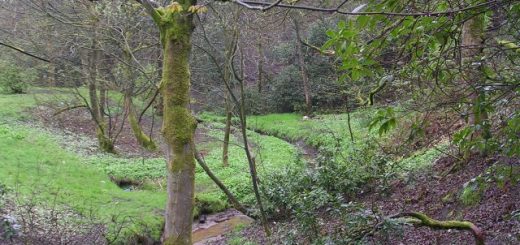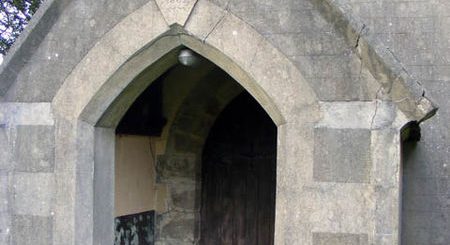Habergham Hall and the Lady’s Lament
Nothing now remains of Habergham Hall which stood on the western boundary of Burnley not far from the cemetery. Ancestral home of the Habergham family, the following extract concerning traditions surrounding the last Mrs Habergham appeared in ‘Lancashire Legends’ (1873) by John Harland & T T Wilkinson.
Habergham Hall, near Burnley, was long the residence of a respectable family of the same name. In the year 1201 Alina and Sabina de Habringham litigated the possession of four bovates of land, about eighty acres, against their sister Eugenia. Roger de Lacy was on good terms with this family, and, in 1204, gave to Matthew de Hambringham two bovates of land in Hambringham. The last heir-male was John Habergham, Esq., who was born in the year 1650, and died without legitimate issue in the beginning of the last century. Where he died, and where he was buried, are not known; for during the latter portion of his life he wandered about as a vagabond, without a home, and deserted by those friends who had assisted in wasting his family estates. He married Fleetwood, daughter of Nicholas Towneley, Esq, of Royle Hall, but their union was not a happy one. She bore with her husband’s misconduct as long as possible; and on being deprived of her home, by the forfeiture of the Habergham estate, she went to reside with her friends, and dying in 1703, was buried at Padiham. Tradition states that Mrs Habergham soothed her sorrow by composing and singing the following stanzas, which are still held in remembrance, not only in the neighbourhood, but throughout Lancashire. They are here reprinted, with some verbal alterations, from Harland’s “Lancashire Ballads:”—
Love’s Evil Choice.
I sowed the seeds of love;
It was all in the spring,
In April, May, and June likewise,
When small birds they do sing.
My garden planted was with care,
With blooming wild-flowers everywhere;
Yet had I not the leave to choose
The flower I loved most dear.
The gardener standing by
Proffered to choose for me
The pink, the primrose, and the rose
But I refused all three.
The primrose I forsook
Because it came too soon;
The violet I o’erlooked,
And vowed to wait till June.
In June the red rose sprang,
But ’twas no flower for me;
I plucked it up, lo! by the stalk,
And planted the willow-tree.
The willow I now must wear,
With sorrows twined among,
That all the world may know
I falsehood loved too long.
The willow-tree will twist,
The willow-tree will twine,
I wish I was in that dear youth’s arms
That once had this heart of mine.
The gardener he stood by
And warned me to take care;
For in the midst of a red rosebud
There grows a sharp thorn there.
I said I’d take no care,
Till I did feel the smart;
And when I plucked the red rosebud,
It pierced me to the heart.
Now I ’11 make a hyssop posy.
No other can I touch;
For all the world do plainly see
I loved one flower too much.
My garden is now run wild;
Where shall I plant anew?
My bed, that once was thick with thyme.
Is now o’errun with rue.




Re: Habergham Hall and the Lady’s Lament
A History of the County of Lancaster: Volume 6 (1911)
HABERGHAM, which gave a surname to the owners. Roger de Lacy, who died in 1211, gave an oxgang of land in Habergham to Matthew de Habergham and his heirs for their homage, a rent of 3s. to be given yearly at St. Giles’s Day. Matthew de Habergham, with the assent of Peter his eldest son, somewhat later gave a moiety of the land he held of John (de Lacy), the constable of Chester, to another son Henry, at a rent of 6d. The tenement thus appears to have been divided into two parts and the descent is not altogether clear. Peter and Henry had sons, and various alienations were made, though Peter de Habergham was recorded as holding the oxgang of land by the old rent of 3s. in 1258. Geoffrey son of Peter de Habergham gave to Adam son of Robert de Holden all the land which he had from Adam son of Matthew through default of homage till the heir should come of age and satisfy Adam. Geoffrey made other grants to Adam his son, Adam de Holden and John de Birtwisle. In 1311 the free tenants were Adam de Holden and Henry de Birtwisle, who held 2 oxgangs of land by rendering 6s. yearly; this is twice the amount granted by the extant charter.
It is probable that Adam the son of Geoffrey was father of the John de Habergham to whom in 1335 Mabel daughter of William son of Matthew de Habergham surrendered all her lands in the hamlet of Habergham in the vill of Burnley, together with the reversion of her mother Ellen’s dower. There is again a defect in the evidence. Ellis de Habergham, chaplain, who was a son of John, and acting as trustee, in 1363 granted to feoffees various lands in Habergham, with the reversion of the dower of Margaret widow of John de Habergham. Richard de Habergham, whose parentage is not recorded, received possession about 1366. The estate or manor descended to Lawrence Habergham, who died in 1615 holding the ‘Hall of Habergham,’ with lands and coal mine there, part of the adjacent Bradley in Hapton and land in Foulridge; his heir was his son John, aged sixteen. John Habergham in 1631 paid £10 as composition for declining knighthood, and in 1638 gave lands to feoffees on marrying Anne daughter of George Pollard of Mill Hill in Hapton; but though he lived through the Civil War nothing is recorded of him, and his descendants sold the estate piecemeal, George Halsted becoming the owner of the hall in 1689 on the foreclosure of a mortgage. After a time the hall, which was rebuilt in 1754, came by bequest into the possession of the Halsteads or Halsteds of Rowley in Worsthorne. It was sold in the middle of last century to Mr. Holt of Goodshaw Fold, who left it to William Preston of Mearley. He took the name of Holt, and was succeeded by his son Mr. Thomas Preston Holt.